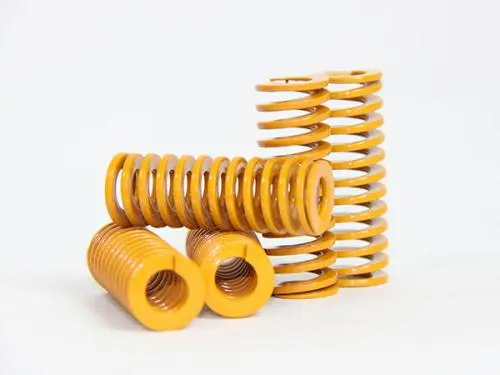Common problems of die spring
Die springs are widely used in industrial production. The following are the common problems of die spring in use. We have to pay more attention for the following problems
Why does the spring break during use?
a. The mandrel is too small or the spring is used horizontally, and the spring and mandrel are worn and broken;
b. When the mandrel is too small / the assembly surface is uneven / the parallelism of the positioning surfaces at both ends is poor, the spring will be compressed and twisted, resulting in local high pressure and fracture;
c. If the mandrel is too short and the end is not chamfered, the spring and mandrel will break due to friction and wear;
d. Foreign matters are mixed between the spring coil and the coil to reduce the actual number of effective coils, resulting in high stress and fracture;
e. The spring is used in series to make it bend and exceed the length of the mandrel or countersunk hole, or the weak load will bear a large amount of compression and break due to the small difference of the spring itself;
f. When the maximum compression is exceeded, high-efficiency stress is generated to break the spring;
g. The spring material is uneven, or the impurity content exceeds the standard, resulting in stress concentration fracture;
h. Over burning, corrosion, over hardness and over rolling of the spring will reduce its tensile and compressive strength and produce fracture.
Why does the spring show “insufficient elasticity” in use?
a. The design and manufacturing parameters of non-standard spring are unreasonable: only pay attention to the parameters such as outer diameter, inner diameter and length, and often ignore the size of wire cross-sectional area and pitch, resulting in insufficient elasticity;
b. The selection of standard spring is unreasonable: due to the low price, the lighter load type is selected and can not bear the heavier load, resulting in insufficient elasticity;
c. Wrong spring quality grade: inadvertently or deliberately use ordinary spring as high-quality spring or imported spring, resulting in insufficient elastic force;
d. Use beyond the specified temperature, resulting in reduced elasticity or even loss of elasticity;
e. The spring wire itself is soft, or the quenching temperature of the spring is low or the holding time is not long enough, or the tempering temperature is too high and the time is long after the spring is formed, resulting in insufficient tensile and compressive strength and insufficient elasticity – this is the real lack of elasticity.







